A Decade of Pandemic Waste:
Abridged Version: Bay Area Services Cut
After
Laying Off At Least 48 Employees, and Massively
Chopping Bay Area Services, SFAF Grants Its
African Affiliate, Pangaea, $22.4 Million – $36 Million
Dedicated
to the Clients and Staff of Bay Area AIDS Service
Organizations Held Hostage by SFAF's “Grantee Model”
Grantmaking |
TheLastWatch
Analysis
Artful
Deception?:
"Grants Payable"
Hidden In "Liabilities"
Turkey
Iceberg,
Massive Layoffs
$22.4
Million in Grants
Diverted to Africa:
Cause of Deficits?
Bay
Area FY '03–'04
Housing Cuts
Bay
Area Prevention
Counseling Cuts
Dearth
of Prevention Social Marketing
SFAF's
25% Solution
The
Unkindest Cut of All: Bay Area ASO Cuts
Abandoning
Bay Area?
|
|
 Note: The media coverage section
of this report is available only on the unabridged page. Note: The media coverage section
of this report is available only on the unabridged page.
Can
anyone seriously believe
that when an HIV/AIDS organization created to address local needs
diverts fully 53% of its program services funds in a single year
to Africa, that it has not
simultaneously cut its services to the Bay Area in order to fund
largess to Pangaea?
When Pat Christen was
quoted in the New York Times in November 2002 that “[SFAF has] the ability to assist in the global
effort, without
distracting from our effort in San Francisco” [emphasis added], she failed to elaborate on
how SFAF intended to divert, at minimum, $22.4 million away from
the Bay Area without detracting from services desperately needed
locally.
|
That’s exactly what SFAF has done: In
just two years it has routed, at minimum, $22.4 million to Africa,
and subsequently cut both services to its Bay Area clients —
including accepting fewer clients, increasing waiting lists for
services, and providing less one-on-one counseling time with its
Bay Area clients — and simultaneously chopped its grantmaking
support to other smaller Bay Area AIDS service organizations,
hypocritically turning its back on its own Bay Area constituents.
In November 2002, the
New York Times underreported that SFAF had “... diverted
$1 million of its money to help establish Pangaea,” SFAF’s new affiliate
non-profit global AIDS spin-off foundation. The Times article reported that “Ms. Christen
said some people
at the foundation were wary about telling donors that money was
being spent overseas. ‘But we’ve always been very
honest with our donors about
what we do with our resources,’ she said [emphasis added].”
[Note: The Times article is in the media section
in the unabridged version of this report.]
Honest? Well, not quite.
Surely Christen knew when interviewed by the
Times in November 2002 that she had created two separate
budgets that six months later, in June 2003, would have completed
diverting the $22.4 million to Africa. That Christen did
not accurately inform the Times reporter the amount diverted
was $21.4 million more than the mere $1 million reported can only
be seen as outright deception, not the very ethical “honesty”
she had attempted to garner for either of her two foundations.
SFAF — and in particular, Christen —
has been anything but forthcoming, let alone honest,
with either its donors, its clients, or the media. Indeed,
as shown in Figure 1, of the $20.5
million SFAF spent on actual “Program Services” in the
period ending June 2002, its audited financial statements show
that in Pangaea’s first year in operation 28.8% ($5.9 million),
at minimum, of SFAF’s budget for Program Services was routed
to Africa. For the previous period ending in June 2001,
SFAF had only awarded a single “global” grant of just
$12,070 (that’s right, just thousands); across a single fiscal
year, global grants soared from the thousands, into millions.
Notably, when SFAF released its budget in July 2001 for
the period ending in June 2002 announcing that it would form Pangaea
in November 2001, SFAF did not honestly forewarn its public that
it intended to divert massive millions to its global “affiliate,”
which funding skyrocketed in its first fiscal year of operations,
diverting well over one-quarter of SFAF’s total Program Services
expenses to fund Pangaea.
The right-hand slices in Figure
1 below show only “grants paid” to Pangaea during its first
two fiscal years in operation, totaling $14,111,664. It
also shows that the percent mix of expenses jumped by 11.5%, from
28.8% to 40.3% ($8.2 million) — or two-fifths — of the
$20.3 million SFAF spent on Program Services in the period ending
June 2003.
Figure 1
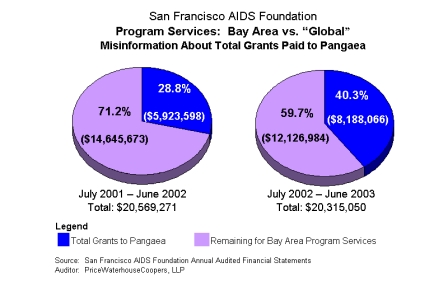
Clearly, services and programs SFAF traditionally
has supplied to people with HIV/AIDS in the Bay Area have been
chopped. In addition to cutting how much it spent overall
on Program Services in the period ending 2003 over the previous
period by $254,221, Program Services for the Bay Area was cut
by $2,518,689 in order to increase the grants actually paid to
Pangaea by $2,264,468, to $8.19 million!
Even though she had told the Times in
November 2002 that SFAF would not detract from its Bay Area services,
just two-and-a-half months later Pat Christen babbled to the Bay
Area Reporter in February 2003 that “the amount of direct services [SFAF]
can provide will be reduced [in the Bay Area].” Under Pat’s so-called “leadership,”
SFAF has prioritized people in Africa as having more urgent direct-service
needs than SFAF’s Bay Area clients, and when eventually forced
to explain service cuts in the Bay Area, Christen dishonestly
kept from telling the truth: That the Bay Area cuts were
made in order to enable SFAF to continue diverting funds to Pangaea.
Top
Artful Deception?: "Grants Payable" Hidden
in "Liabilities"
The combined $14.1 million paid to Pangaea
in the first two years of its existence shown in Figure 1 is misleading,
precisely because SFAF deceptively did not include a separate
category of additional “grants payables” in its summary
of Program Services expenditures detailed in a chart on page 4
of the June 2003 audited financial statement.
Taking a lesson from
the Artful Dodger, in order not to frighten the horses (its Bay
Area clients, its donors, and the media), rather than reporting
honestly that it had actually doled out additional funds to Pangaea,
SFAF chose instead to under-report the actual amount it had spent
on “Program Services” by squirreling away that it was
on the hook financially to pay out additional “Grants Payable”
to Pangaea in both FY ’01–’02 and FY ’02–’03.
The PriceWaterhouseCoopers audited financial reports show
that SFAF had placed additional Grants Payable to Pangaea under
its “liabilities and net assets” figures, which are
not reported as an actual “Expense” under Program Services
during the same reporting period. Indeed,
while $5,698,669 in “Grants Payable” appears on page
2 of the June 2003 audited financial report, it is not until page
7 that PriceWaterhouseCoopers notes that $5,433,422 of the Grants
Payable was owed to Pangaea as
a “liability” using revenue or net assets from the same
reporting period.
Its curiosity roused, TheLastWatch decided
to examine how “grants payable” changed the picture.
Based on data
in the audited reports from PriceWaterhouseCoopers, TheLastWatch
added the “Grants Payable” to the total amount of Program
Services, and recalculated the proportion of grants SFAF awarded
to Pangaea.
The right-hand slices in Figure 2
illustrates a scenario of what really transpired: Across
a single fiscal year for the period ending in June 2003, between
grants paid + grants payable SFAF increased the amount it paid
to Pangaea by $5.4 million to $13.6 million, not the $8.2 million
for the period ending in June 2003 shown in Figure 1, even as
it sucked $2.5 million away from services in the Bay Area in order
to do so.
And rather than a total
of $14.1 million routed to Pangaea by combining the two right-hand
slices in Figure 1, combining the two right-hand slices in Figure
2 reveals that $22.4 million has been routed to Pangaea during
its first two years of operation for both grants paid + grants
payable in this modified view of total “Program Services.”
Figure 2
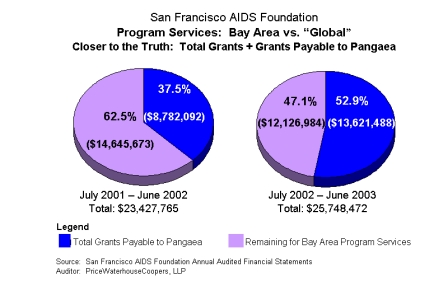
But that is not all
that a comparison of Figure 1 to Figure 2 illustrates. Across
a single fiscal year, the percent reserved for its Bay Area program
services plummeted from 71.2% (Figure 1, which can be thought
of as spin control by excluding grants payable) to only 47.1%
(Figure 2, a more reality-based view of what transpired), a drop
of fully 24%, while at the same time the percentage devoted to
Pangaea skyrocketed from 28.8% to 52.9% by adding in the grants
payable.
The Big Question is
why SFAF would have used this new “grants payable” trick.
Why did it not simply pay the grants payable and list them as
a Program Services expense in its chart on page 4 of the audited
financial statement? One answer may be that because listing in
its chart on page 4 that it had diverted $8.78 million to Africa
during Pangaea’s first year of operations and had diverted
an additional $13.6 million to Pangaea in its second year —
totaling the $22.4 million — was simply too risky, even for
brazen and gutsy Pat Christen, since she and SFAF have been unable
to make the case to its donors and its Bay Area clients that this
diversion was a wise idea. Pat babbled in the Times article
about the risk being worthy, provided a case had been made for
the risk, but the truth is the case wasn’t made publicly
— let alone even presented completely or truthfully to its
donors and clients — before
SFAF leapt into the very risky business of diverting tens of millions
of dollars to Africa.
SFAF possibly may have
deliberately
chosen to
utilize grants payable tucked away under “total liabilities
and net asssets” precisely in order to camouflage the massive
amount of grants it was obligated to pay to Pangaea to prevent
a public uproar. Indeed, SFAF’s former auditors, Deloitte
& Touche LLP, had never utilized the “grants payable”
construct in any of SFAF’s audited financial reports it had
issued, the last of which D&T conducted for the period ending
in June 2000; and PriceWaterhouseCoopers did not list grants payable
on is first audited financial report for the period ending in
June 2001. It was not until after Pangaea was created in
November 2001 that PriceWaterhouseCoopers began listing grants
payable for the first time in SFAF’s audited report for the
period ending June 2002.
Another way of looking
at Figure 2: For the period ending in June 2003, SFAF
diverted 53% of its program services funds to Pangaea and Africa. This is hardly
the 25% of fundraising proceeds Christen
blabbed to the New York Times about, trying to “make
a case” for the change in SFAF’s focus and a so-called
“change in mandate,” by claiming that diverting 25%
of its revenue to Africa would be acceptable to all of SFAF’s various
Bay Area constituencies.
Top
Turkey Iceberg, Massive Layoffs
Just three days after
the Times article, on November 21, 2002 the Bay Area
Reporter weighed in on SFAF’s service cuts to people
with HIV/AIDS by way of eliminating its traditional Thanksgiving
dinner for its clients. But the B.A.R. and other
media outlets fell victim to SFAF’s propaganda — as
have many of SFAF’s AIDS Walk, AIDS Ride, and AIDS marathon
participants and the smaller Bay Area organizations held hostage
by SFAF’s “beneficiary model” grantmaking, the
very model SFAF battled with Palotta Teamworks over who would
control the California AIDS Ride — that SFAF had a budget
shortfall resulting in an insufficient number of staff to host
the holiday event. Nothing could be further from the truth:
At the same time SFAF was crying poor in November 2002, it was
half-way through the July ’02 – June’03 fiscal
year in which its revenue from individual donors and foundations/corporations
would soar by almost $3.4 million (so there had been no need to
have already laid off 28 of its employees in July ’02, creating
the staff shortage it later used to justify slicing turkey dinner
in November ’02 from its menu of client services before it
sliced an additional 20 employees from its payroll in February
’03 in its second round of layoffs in the same fiscal year).
A year before SFAF beheaded
its Thanksgiving dinner for its clients in 2002 (which dinner
was subsequently not restored for Thanksgiving 2003), it had already
launched on November 29, 2001 its affiliate non-profit arm —
the Pangaea Global AIDS Foundation, so named after a hypothetical
supercontinent presumably containing Earth’s single land
mass that split apart 200 million years ago. And even as
it cut Thanksgiving dinner in 2002 and 2003 to its gay and bisexual
male clients, it continued to hold a Christmas luncheon only for
its female clients in 2002, though that, too, may have been chopped
in 2003, as information about the Christmas luncheon 2003 is not
listed on SFAF’s web site. Its Christmas and Thanksgiving
meals were beheaded in order to help fund the $22.4 million grants
to Pangaea.
Chopping turkey dinners
— and ignoring that its AIDS clients may not feel comfortable
being served Thanksgiving dinners in other, possibly hostile alternate
venues — is but the tip of the iceberg in SFAF’s subsequent
reduction in services to the Bay Area HIV/AIDS community. Indeed,
its claim of insufficient staff, and not insufficient cash, as
the reason to eliminate its Thanksgiving dinner, is hogwash, as
according to its audited financial statements SFAF’s payroll
for its global operations skyrocketed between June 2002 and June
2003 by almost $500,000, indicating it hired more staff for its
global operations in 2003 during the same year it had fired a
combined 48 people from its domestic, local operations staff.
And at every opportunity it is afforded to explain honestly cuts in services to its clients,
SFAF winds up every explanation by petulantly crying poor, begging
people to please give it more money by attending its various fundraisers,
despite the fact that its fundraising has not been permanently
or irreparably hurt by either 9/11 or a sluggish economy, as shown
in figures 4 and 5 below. [Note: Figure 5 illustrates that individual
giving post-9/11 has soared by $261,000 at the end of June 2003,
well over pre-9/11 giving.] SFAF’s repeated entreaties
of “give us more money” are designed to enable it to
turn around and give the money to Africa, not provide services
in the Bay Area.
Lest anyone think TheLastWatch
and SFAF’s clients are merely whining about turkey dinners,
consider what SFAF has done to its Bay Area housing programs.
After
various ASO’s (including SFAF) and other organizations have
conducted costly so-called “needs assessments” across
the years costing literally millions of dollars, all of which
assessments have consistently identified housing as the greatest
unmet need in San Francisco, SFAF has turned a blind eye to housing
services in order to march over to Africa. Disturbingly,
between FY ’00–’01 and FY ’03–’04,
SFAF cut $207,319 in housing subsidies and housing vouchers to
Bay Area clients from its budget, and chopped a whopping $1,523,172
from its various housing programs, since FY ’00–’01,
as shown in Figure 7. (Africa,
pay attention; housing or medical services that SFAF and Pangaea
may start out helping you with initially could eventually be cut
when next Pangaea changes its priorities,
possibly heading off next to India.)
Top
$22.4 Million in Grants Diverted to Africa: Cause
of Deficits?
In July
2003, the Bay Area Reporter editorialized that it was time
for SFAF to revamp the processes it uses to distribute revenue
equitably, by distributing AIDS Walk revenue “to groups other
than itself.” In an accompanying article, the B.A.R.
noted that just $370,000 of $3.1 million raised at San Francisco’s
July 2003 AIDS Walk would be “spread out among some 30 other
agencies.” [Note: In recent years, it is actually
33 to 36 other agencies who are purportedly to be beneficiaries
of the Walk, and indeed, SFAF spreads heavy propaganda leading
up to its fundraising events that it will share the money with
so many organizations in order to pump up public participation,
hoping heart strings will be yanked, and more money will be raised
so it can siphon the money off to Africa.] One agency in
San Francisco, Continuum, which provides adult day health care
for people with AIDS possibly including physical therapy treatments,
saw its 2003 “beneficiary model grant award” from SFAF’s
AIDS Walk revenue plummet to $2,500, down from the $25,000 it
had received from AIDS Walk 2002.
In just
two years, SFAF has diverted, at minimum, $22.4 million to Africa
while Bay Area residents with HIV/AIDS remain desperate for emergency
direct financial assistance and housing vouchers, and while Bay
Area ASO’s dependent on SFAF’s grantmaking remain desperate
for funds to help their clients. As shown in Figure 3, across just
two fiscal years SFAF’s audited financial statements show
that it had “provided grants to Pangaea” during the
respective years, in addition to having remaining “grants
payable to Panagea,” totaling the $22.4 million.
In both
audited statements — for July 2001–June 2002 and July
2002–June 2003 — PriceWaterhouseCoopers, SFAF’s
auditors, used very precise language that the grants payable were
“in addition to” grants actually awarded, indicating
that SFAF was financially on the hook to pay the grants payable.
As of this writing [December 2003], SFAF is already
half-way through its current fiscal year for the period ending
June 2004, and no documentation will be available to determine
how many more millions will be diverted this year to Africa until
SFAF releases its audited financial statement for July 2003–June
2004 in December 2004.
Figure 3
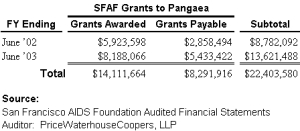
In February
2003 during the midst of fiscal year ’02–’03 ending
in June 2003, SFAF claimed it faced a $700,000 shortfall (“SFAF
announces budget cut specifics,” Bay Area Reporter,
February 6, 2003, below) and would have to cut services to its
Bay Area clients, including accepting fewer clients, providing
less one-on-one [counseling] time between clients and staff, increasing
waiting lists for services, and cutting other “non-essential”
services. (Well, if those services had not been “essential”
in the first place, what exactly were they, and why had they been
previously provided?) In addition, the article noted SFAF
was laying off an additional 20 staff members, bringing the number
of domestic staff SFAF had fired to 48, (fewer staff obviously
means fewer clients will be seen, which is a cut in services in
its own right) anticipating another $1.6 million deficit for FY
’03–’04. Facing a combined $2.3 million purported deficit across
the two fiscal years did not stop SFAF from awarding its global
affiliate, Pangaea, $13.6 million in grants and grants payable
in 2003 and another $8.8 million in 2002, even as it chopped services
to its Bay Area clients in order to fund the largess to Pangaea.
The
20 layoffs in February 2003 were in addition to the 28 layoffs
announced in June 2002 scheduled to take effect in July 2002,
which SFAF blamed on a $2.5 million budget gap (“Pat takes
a pay cut,” Bay Area Reporter, June 20, 2002, on the
Bloated Salaries section on the SFAF main page on this web site).
It is unclear why there was a $2.5 million budget gap in
June 2002 and possibly a different budget gap of $2.3 million
announced in February 2003, when, in fact, total revenue had climbed
by $6.4 million dollars across the two-year period (end of June
2001 to end of June 2003). And SFAF has not explained why
it claimed to have budget gaps in both 2002 and 2003 yet still
awarded Pangaea $22.4 million in grants. Perhaps the grants are
the very reason there have been budget gaps, but neither SFAF
nor Pangaea have been forthcoming about which came first, the
chicken (the $22.4 + million in grants) or the egg (the purported
“budget deficits” SFAF reported in both June 2002 and
February 2003).
[Note: In addition
to the grants payable to Pangaea, SFAF also had other grants
payable of $776,393 ending in June 2002 and $265,247 ending in
June 2003 for a total of $1,041,640 across the two years, both
of which were tucked away under “liabilities.” But
neither of its two audited financial statements indicated who
was to receive the extra grants payable (i.e., local/domestic
vs. global ASO’s), nor how and from which accounts SFAF would
pay them. Those additional grants payable may also have
contributed to the purported budget deficit causing the loss of
services to the Bay Area.]
So just
how did SFAF find the largess to award Pangaea tens of millions
of dollars in grants it claimed it didn’t have to help Bay
Area residents living with HIV/AIDS? Well, SFAF claimed
that Pfizer, Inc. — the international pharmaceutical giant
known for its high-priced AIDS medications, among its other high-priced
pharmaceuticals — had awarded SFAF an $11 million dollar
grant to launch Pangaea in November 2001. But disturbingly,
while PriceWaterhouseCoopers noted in SFAF’s annual financial
statement for the period ending in June 2002 that SFAF had “recognized
$4.4 million of the Pfizer grant during the year ended June 30,
2002,” and the remainder [of the $11 million] would be “recognized
as [SFAF] meets the conditions associated with the [Pfizer] grant,”
there is no mention in the PriceWaterhouseCoopers audited financial
statement for the period ending in June 2003 that SFAF had either
a) Finally “recognized” the balance of the Pfizer grant
the previous year, nor b) That SFAF had eventually received another
portion of the funding from Pfizer for the period
ending in June 2003, if it was, in fact, a Pfizer multiyear grant.
In order
to have a deficit, an organization needs one of two things: Deceased
revenue, or excessive spending (or a combination of the two).
As shown in Figure 4, SFAF did not have decreased
revenue causing a budget deficit; indeed, across a mere two year
period SFAF saw its revenue soar by $6.4 million (and its overall
revenue may have climbed even higher in the current fiscal year
which will end in June 2004).
Figure 4
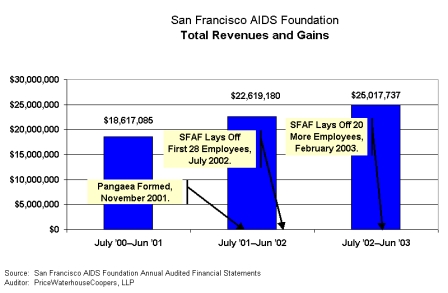
And
while Christen was quoted in the February 6, 2003 B.A.R. that
“Government deficits are very significant at the city, state,
and federal levels,” in a bald attempt to deceive the public
about why services at the Foundation have been cut at SFAF for
the past three years, the truth of the matter is that SFAF has
only seen a modest decrease in its government contracts during
the same period. While its audited financial statements
show a decline of only $426,115 in “government grants”
across these three fiscal years (see the Annual Audits section
on the SFAF main page on this web site), Figure 5 illustrates
that SFAF simultaneously had seen an increase of over $261,384
in increased fundraising from individual donors, and a staggering
$6,716,492 increase in contributions from corporations and foundations,
across the three audited financial statements. SFAF does
not have a revenue
shortage on its hands, as it wants to mislead us. Instead,
it has experienced a $6.4 million to $7 million increase in revenue
since the end of June 2001.
Figure 5
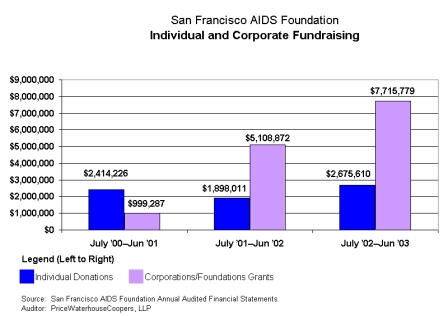
That
leaves “excessive spending” as the cause of any possible
deficit we are being mislead by SFAF into believing has occurred.
And the excessive spending points in only one direction:
East by South-east, to Pangaea in Africa.
Christen
brazenly noted in the B.A.R. February 6, 2003 article (“SFAF
announces budget cut specifics,” below) that “There is no
escaping the unfortunate
reality that the amount of direct services [SFAF] can provide
will
be reduced [emphasis
added].” The unfortunate reality, more honestly, is
that direct services to Africa were increased, but could not have
been without reducing direct services to the Bay Area.
And
while SFAF would like to dupe the public into believing it chopped
services in the Bay Area due to a loss in fundraising revenue
— expecting us to ignore both the increase in individual
(non-fundraising event) revenue and the increase in corporate/foundation
revenue noted in Figure 5 — the truth of the matter is that
across the last two fiscal years, as shown in Figure 6, SFAF has lost
only $756,561 in net income from fundraising events, bringing
its total increase in revenue down from $7 million to $6.4 million.
Figure 6
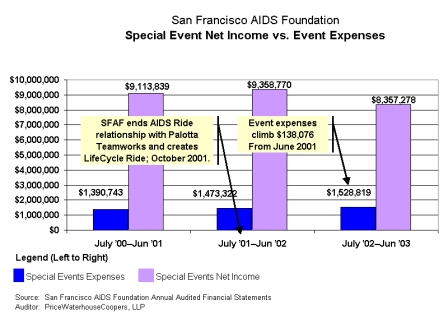
In the
end, SFAF’s largess to Pangaea can only be seen as part and
parcel of SFAF’s decade of pandemic waste: In the Winter
2002 issue of its publication, BETA (Bulletin of Experimental
Treatments for AIDS), Pangaea noted “Unless [our] initiatives
build good, solid infrastructure to sustain and manage these projects
[in Africa] over the long term, we will have wasted
a tremendous amount of resources [emphasis added].” From
the perspective of many of SFAF’s Bay Area clients, and the
smaller ASO’s hurt by SFAF’s diversion of resources
to Africa, SFAF has already proved to be wasting resources Bay
Area donors had contributed to SFAF in the expectation of helping
resolve the Bay Area’s unmet HIV/AIDS needs.
Top
Bay Area FY '03–04 Housing Cuts
After
various ASO’s (including SFAF) and the City and County of
San Francisco have spent literally millions of dollars —
including federal Ryan White CARE Act funds intended to provide
actual healthcare services to people with HIV/AIDS — across
the years to learn what the greatest unmet needs are for people
with HIV/AIDS in San Francisco, which costly so-called “needs
assessments” have consistently identified housing as the
greatest unmet need, SFAF has turned a blind eye to housing services
in order to establish a beachhead in Africa. Indeed, across
the four fiscal years shown in Figure 7, despite having identified
housing repeatedly as the greatest unmet need of people living
with HIV/AIDS in the Bay Area, SFAF has cut from its budget $207,319
in housing subsidies and housing vouchers, and a staggering $1,523,172
from its various housing programs since FY ’00–’01.
Figure 7
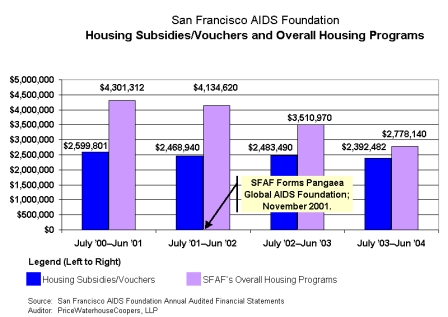
Top
Bay Area Prevention Counseling Cuts
As reported
elsewhere on this web site (repeating information on the Gay Life
workshops page):
SFAF
reported the number of Gay Life workshop attendees on only one
of its tax returns, for the period ending in 1998, reporting 204
participants. In subsequent tax filing years, SFAF lumped
together the Gay Life workshops with the Black Brothers Esteem
(BBE) workshops, reporting an aggregate number, so determining
attendance trends only for the Gay Life workshops is difficult
to ascertain. That said, it is troubling that SFAF’s
tax returns show that the number of gay and bisexual men receiving
(apparently one-to-one) prevention case management has dropped
every year: From 177 gay/bi men in 1998, to 157 (1999),
116 (2000), 105 (2001), and 101 (2002) — which is particularly
troublesome since the 2000 to 2002 City of San Francisco general
fund contract stated that for 2001 and 2002, 125 clients would
be served with prevention case management (being short by 20 and
24 clients according to its tax returns, respectively, in those
years, for an approximately 19% gap in the number of clients to
be served).
That’s
right: Contracted
to have provided case management services to 125 clients, SFAF
appears to have been able to locate only 101 Dalmatian's (err
… 101 clients) in 2002 interested in having their gay lives
case-managed by SFAF. As well, the 2000–2002
SF DPH contract stated that 1,160 clients would be served by other
non-case management components of the BBE and Gay Life programs
each year, yet SFAF’s tax return for the period ending in
June 2002 boasted in Statement 6 that only 649 — not 1,160
— had received these services, leaving a reasonable person
to wonder whether 511 clients (44% of those projected in the contract)
simply went unserved. How can SFAF be reporting one set
of data to the IRS, and possibly other data to DPH hoping to bypass
the scrutiny of DPH’s contract compliance officers’,
and the San Francisco Health Commissions’, radar?
Top
Dearth of Prevention Social Marketing

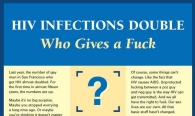 Since
launching Pangaea in November 2001, SFAF has not conducted any
print media prevention advertising campaigns in the Bay Area.
Just ask the Bay Area Reporter, who has been paid
only to run SFAF’s Gay Life workshop registration and promotion
advertisements; the B.A.R. will know that no prevention
media campaigns have been conducted by SFAF since mid-2001, since
the two ads to the right were last run.
Since
launching Pangaea in November 2001, SFAF has not conducted any
print media prevention advertising campaigns in the Bay Area.
Just ask the Bay Area Reporter, who has been paid
only to run SFAF’s Gay Life workshop registration and promotion
advertisements; the B.A.R. will know that no prevention
media campaigns have been conducted by SFAF since mid-2001, since
the two ads to the right were last run.
In January
2001, the Institute of Medicine (IOM) issued a report titled No
Time To Lose: Getting More From HIV Prevention. SFAF’s
Public Policy Department must, surely, have read the IOM report
before it launched Pangaea eleven months later in November 2001.
One of the IOM’s “research institutions”
reviewers was none other than Thomas Coates, PhD, whose agency,
the UCSF Center for AIDS Prevention Studies had been contracted
to provide an efficacy analysis of SFAF’s “Gay Life”
program, which analysis has never been released to the public,
perhaps because the program may have low efficacy results. The
IOM’s report noted that social marketing advertising campaigns
“show remarkable efficacy in preventing new HIV infections,”
and “can be highly cost-effective because they can inexpensively
reach large numbers of at-risk individuals” (page 117). Other
HIV prevention authorities have long noted that sustained and
consistent social marketing media ad campaigns presenting basic
prevention information are a key component in preventing additional
HIV infections.
In 1998,
Stephen LeBlanc noted in a Bay Area Reporter article, (“Infection,
Reinfection: Can We Talk?,” Bay Area Reporter, July
23, 1998, page 27) that SFAF’s 1997 Compass Prevention [advertising]
Project had:
- “…
vanished, replaced by the … ‘Gay Life’ program.
Each project was launched with a new media campaign, new
brochures, new logos, and each spent tens of thousands of dollars
on advertising. And they all avoided any specific messages
about safe-sex or HIV transmission or treatment. Activists
contend that they would be less concerned that these flagship
[advertising] programs were not directly addressing safe-sex
if other media campaigns were filling that gap. Unfortunately,
that has not been the case.” LeBlanc further noted
“At one point we gave people basic information … Then
we made a quantum shift to programs that attempt to enhance self-esteem
or deal with psycho-social aspects of HIV, but I think we left
the field of the basic prevention information that needs
to get out there [unaddressed]” [emphasis added].
Indeed,
SFAF’s FY 1999-2000 Budget noted that “[The Assumptions]
multi-year risk reduction campaign [is intended] to encourage
community dialogue on issues surrounding HIV disclosure and assumptions.
… Addressing HIV disclosure assumptions is the most important
impact we can have on new sero-conversions among non-injection
drug using gay men in San Francisco.” But instead of
a three-year sustained media campaign, SFAF then unilaterally
internally changed its “most important” mandate by cutting
short the three-year media campaign in order to launch Pangaea.
SFAF’s
controversial “Who Gives a Fuck” ad sparked community
outrage in 2000, and the Assumptions Phase II ads designed with
a gritty look-and-feel abruptly ended in early 2001, despite SFAF’s
1999 debut of the “Assumptions” claiming the prevention
ads were supposed
to have been a
three-year (36-month) campaign. But the Assumptions campaign
died an early death, possibly curtailed to launch SFAF’s
global annexation, at just about the same time it was preparing
to launch Pangaea in November 2001; rather than a three-year media
campaign, the Assumptions ads — albeit costing between $650,000
and, potentially, $1.4 million — were a two-year flash in
the pan sacrificed from the mix of services to its Bay Area clients,
new HIV infection rates in the Bay Area be damned so Pangaea could
be birthed.
What
has ensued — since Pangaea was formed to channel funds to
Africa — is a complete dearth (as in, complete absence) whatsoever
of any social marketing prevention media campaign sponsored by
SFAF in San Francisco, since SFAF has ignored that Bay Area need
for now well over two years beginning in mid-2001. And callously,
the cut of social marketing prevention ads may have directly contributed
to purported rates of rising HIV infection in San Francisco. How
ironic is it, that the very organization trying to stem the rise
in HIV cases in San Francisco has abandoned, for well over two
years, any sense of ethics in utilizing social marketing prevention
ads in the Bay Area, merely in order to have additional Monopoly
money to divert to Africa, instead?
Top
SFAF’s 25% Solution
At its
Summer 2001 Board of Directors meeting, SFAF’s staff —
in particular, Pat Christen — promised its Board that it
would not divert funds from the Bay Area in order to launch Pangaea
the following November; it had further promised not to launch
Pangaea unless sufficient revenues were raised independently to
prevent having to rob Peter to pay Paul to launch Pangaea. The
promise was repeated in its annual Budget document for FY ’01–’02:
“While we are optimistic about the likely success of
the Marathon given strong runner registration numbers to date,
as a first-year event we have been very conservative in actually
relying on AIDS Marathon funds to support [global] operations.”
While projecting $3.7 million in revenue from the newly created
AIDS Marathon (before subtracting event expenses), and although
it grossed $3.8 million from the first Marathon, the California
Attorney General’s report showed that only $2.28 million
went to SFAF, since event overhead expenses had gobbled $1.63
million, as shown in Figure 8.
Missing
from Figure 8 is how much money SFAF had raised from its newly
formed LifeCycle 1 event, which was first held in the summer of
2001 after breaking away from Palotta Teamworks following the
nasty legal battle over the California AIDS Ride. Since
it claims it is now producing its new Ride without the help of
a third-party commercial fundraiser event producer, SFAF has neglected
to file with the Attorney General’s office a statement showing
overall revenue, event expenses, and how much was realized in
net proceeds from its LifeCycle ride. But if we are to believe
Pat Christen that just 25% of only the Marathon revenue would
be used to support Pangaea, Figure 8 illustrates that even adding
in 25% of net revenue from the AIDS Walk (without having told
its walkers prior to the event that it might divert Walk money
to Pangaea) nowhere near adds up to the $8.8 million dollars SFAF
diverted to Pangaea between grants paid + grants payable shown
in Figure 2 above during the same fiscal year as the fundraisers
shown in Figure 8 (i.e., fiscal year July ’01–June ’02).
Figure 8
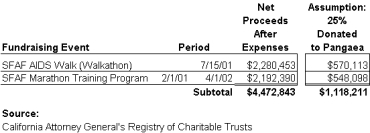
Indeed,
the paltry $548,098 raised by marathoners — representing
25% of just the Marathon net proceeds — would have only reduced
the $8.8 million first-year burden in grants + grants payable
to Pangaea to $8.2 million for fiscal year ’01–’02.
And since Pfizer had only released $4.4 million in the first
year of its three-year grant to launch Pangaea, SFAF would, therefore,
have been on the hook for the $3.8 million remaining in the balance
from the $8.2 million. Most probably, SFAF made up the $3.8
million by dipping into funds raised by its bike riders and the
AIDS walkers — without telling them prior to those events
that was what it would eventually do. And indeed, the list
of grants SFAF awarded and attached to its IRS tax forms for the
period ending in June 2002 (the most recently released tax return)
— which list for years had been titled as grants made from
the AIDS Walk — shows that SFAF had awarded grants of $5.9
million to Pangaea from its various fundraising events.
But
the numbers don’t add up: If the $5.9 million SFAF
reported to the IRS represented only the grants paid and had not
included “grants payable,” and if Pfizer had contributed
only $4.4 million, that left SFAF holding the bag for the remaining
$1.5 million it awarded Pangaea in grants paid, but does not explain
how the additional $2.86 million in grants payable for FY ’01–’02
to Pangaea was paid. SFAF was on the hook for between $4.2
million and $4.4 million in grants + grants payable to Pangaea,
but it has offered no explanation of which fundraising sources
were eventually tapped, or which Bay Area services were cut, to
pay the Pangaea piper.
SFAF
cannot claim that the increased corporation/foundation revenue
shown in Figure 5 could have footed this bill to Pangaea, as of
the $5.1 million noted in Figure 5, Pfizer had contributed $4.4
million, leaving a modest balance of $708,872 in corporate/foundation
giving in FY ’01–’02 to pay the $4.3 million owed
to Pangaea. Notably, without the Pfizer grant, SFAF would
have seen a $291,000 decrease in corporate/foundation giving from
the previous FY in ’00–’01, in addition to the
$516,000 decrease in individual giving noted in Figure 5 for FY
’01–’02. Yet despite this fall off of $807,000
between decreased corporate/foundation and individual giving in
FY ’01–’02, — and despite being on the hook
to other organizations besides Pangaea for an additional $776,393
in grants payable in FY ’01–’02 — SFAF still
managed to divert $4.3 million of its own funds to Pangaea, possibly
by dipping into non-Marathon fundraising.
In the
end, SFAF’s assertion to the New York Times that it
would divert no more than 25% of its fundraising to Pangaea does
not pan out. Examining Figures 1, 2 and 8, SFAF’s diversion
of tens of millions of dollars to Pangaea does not add up to 25%
of fundraising event revenue, and the loss of direct services
to the Bay Area has been staggering.
It has
been substantially more than a mere “25% Solution.”
And what now needs to follow in the Bay Area should be substantial,
sustained, and quite vocal opposition to SFAF’s diversion
of further resources away from unmet needs to San Francisco and
our Bay Area neighbors. Because without vocal opposition
now, the diversion of funds to Pangaea will continue, and likely
grow.
Top
The Unkindest Cut of All: Bay Area ASO Cuts
Elsewhere in this report
it has been noted that SFAF has chopped the amount of funds it
shares with the smaller Bay Area AIDS service organizations, and
has simultaneously slashed its domestic by firing least 48 of
its employees.
Indeed, across a single
FY — from ’01–’02 to ’02–’03
— SFAF has slashed its salaries budget for domestic staff
providing Program Services, by $1,985,382 (even as it increased
its salaries budget for Fundraising by $314,196 across two-years,
FY ’00–’01 to FY ’01–’03) during
Pangaea’s second year of operations in which the 48 domestic
employees were fired. After all, SFAF needed that $2 million in
domestic salary savings to help fund its Pangaea operations overseas.
As well, the July 24,
2003 Bay Area Reporter editorial “AIDS Walk Needs Revamping”
(located on he Fundraising section of the main SFAF page on this
web site) noted that only $370,000 of the AIDS Walk 2003 funds
would be shared with the smaller Bay Area ASO’s, down significantly
from previous years. The distribution of AIDS Walk funds shared
is covered in detail on the Fundraising page, and it is probable
the other Bay Area ASO’s have also had to lay off staff in
the face of dwindling “grantee model” support from SFAF.
So the unkind cut of
staff members across agencies who had been providing direct services
to people with HIV/AIDS in the Bay Area has led directly to the
unkindest cut of all: SFAF is not just forcing its own clients into longer waiting
lists when not eliminating services entirely; the unkindest cuts
are to those clients of other
Bay Area ASO’s who are experiencing the trickle-down effect
of SFAF’s cuts, when many of those clients participated in
the AIDS Walks, AIDS Rides, and the AIDS Marathons hoping their
agencies would receive a larger slice of the pie, and have seen
the money routed to Africa, instead. (For more on the unkindest-of-cuts
to the ASO’s, see the SFAF Fundraising section on this web
site.
Top
Abandoning Bay Area?
In November 2002 — just seventeen days
before the New York Times article appeared in print —
SFAF merged its third non-profit affiliate, the “San Francisco
AIDS Foundation HIV Prevention Project” (or HPP, a needle-exchange
program) into a single non-profit with SFAF. That merger
resulted in a contribution of net assests from the HPP to SFAF
of $328,696 according to its audited financial statement for the
perdiod ending June 2003.
Given that 53% of its program services expenses
were diverted to its other “affiilate” non-profit, Pangaea
(which shares the same 995 Market Street address as SFAF), in
the same fiscal year as the merger with HPP, reasonable observers
wonder how long it will be before SFAF simply merges with Pangaea
into a single non-profit, by claiming that its sole “mandate”
will be its partnership with Pfizer, Inc. and its other partners
in Africa.
Should that eventuality come to pass SFAF’s
Bay Area clients, and the smaller ASO’s who have been held
hostage for years by SFAF’s “grantee model” of
grantmaking, can kiss SFAF’s direct services to the Bay Area
goodbye. To prevent any such eventuality, SFAF’s donors
should immediately stop contributing to SFAF, if they really want
to preserve services to people living with HIV/AIDS in the Bay
Area.
Failure to do so will only hasten SFAF’s
merger into a single global foundation with Pangaea, as it despicably
and hypocritically turns its back on the Bay Area.
Top
_______
Copyright (c) 2004 by Patrick Monette-Shaw. All rights reserved.
This work may not be reposted anywhere on the Web, or reprinted
in any print media, without express written permission of the
author. E-mail him at pmonette-shaw@earthlink.net.
![]() Note: The media coverage section
of this report is available only on the unabridged page.
Note: The media coverage section
of this report is available only on the unabridged page.







 Since
launching Pangaea in November 2001, SFAF has not conducted any
print media prevention advertising campaigns in the Bay Area.
Just ask the Bay Area Reporter, who has been paid
only to run SFAF’s Gay Life workshop registration and promotion
advertisements; the B.A.R. will know that no prevention
media campaigns have been conducted by SFAF since mid-2001, since
the two ads to the right were last run.
Since
launching Pangaea in November 2001, SFAF has not conducted any
print media prevention advertising campaigns in the Bay Area.
Just ask the Bay Area Reporter, who has been paid
only to run SFAF’s Gay Life workshop registration and promotion
advertisements; the B.A.R. will know that no prevention
media campaigns have been conducted by SFAF since mid-2001, since
the two ads to the right were last run.